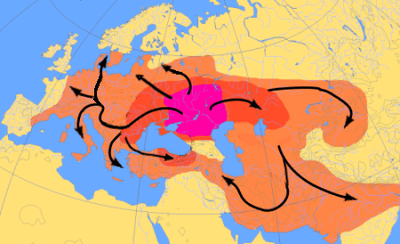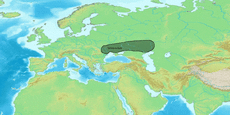The Horse, the Wheel and Language

| Part of a series on |
| Indo-European |
|---|
 |
|
|
Origins |
|
Archaeology Pontic Steppe East-Asia Eastern Europe Northern Europe Pontic Steppe Northern/Eastern Steppe Europe
South-Asia Steppe Europe Caucasus India |
|
Peoples and societies Indo-Aryans Iranians Europe East-Asia Europe Indo-Aryan Iranian |
|
|
The Horse, the Wheel, and Language: How Bronze-Age Riders from the Eurasian Steppes Shaped the Modern World (ISBN 0-691-05887-3) is a 2007 book by David W. Anthony, which describes his "Revised Steppe Theory." The book explores the origins of Indo-European languages (now spoken by three billion people) in the context of the domestication of the horse and invention of the wheel in the Eurasian Grass-Steppe of the temperate grasslands, savannas, and shrublands. It won the Society for American Archaeology's 2010 Book Award.[1]
Description
The relevant archaeological evidence for the early origins and spread of the Indo-European languages is examined, giving support to a version of the Kurgan hypothesis. A key insight is that early expansions of the area in which Indo-European was spoken were often due to "recruitment", rather than due only to military invasions. With the Yamna culture as a nucleus candidate, the original recruitment would be to a way of life in which intensive use of horses allowed herd animals to be pastured in areas of the Ukrainian / South Russian steppe outside of river valleys. According to Anthony's researches, the earliest effective domestication of horses occurred in approximately the same period and geographical area where the Indo-European languages started to spread. The splitting off of the major branches of Indo-European (except perhaps Greek) can be correlated with archaeological cultures showing steppe influences, in a way that makes sense chronologically and geographically in light of linguistic reconstructions.
Anthony generally favors Marija Gimbutas’s Pontic-Caspian steppe homeland for the original Indo-European speakers (the Kurgan hypothesis), but eschews the apparent essentialism of Gimbutas’s later work; he de-emphasizes the stress she put on the Indo-European warfare, and stresses instead the cultural and economic aspects of interaction between the Indo-Europeans and the society of "Old Europe".[2]
Proto-Indo-European language
On linguistic front, Anthony proposes that the Proto-Indo-European language emerged after ca. 3500 BCE. He bases this especially on his analysis of Indo-European terms for wool textiles and wheeled vehicles,
Neither woven wool textiles nor wheeled vehicles existed before about 4000 BCE. It is possible that neither existed before about 3500 BCE. Yet Proto-Indo-European speakers spoke regularly about wheeled vehicles and some sort of wool textile. This vocabulary suggests that Proto-Indo-European was spoken after 4000–3500 BCE.[3]
Thus, Anthony challenges Colin Renfrew's Anatolian hypothesis that proposed a very long-lived Proto-Indo-European development phase. Renfrew proposed that early Proto-Indo-European developed by around 6500 BCE, originating in the famous Neolithic site at Çatalhöyük in Turkey.[4]
Evaluation
Anthony discusses in some detail the archaeological evidence from the steppes, and how it can be interpreted in light of his suggested historical-linguistic framework. But, in a review, Philip L. Kohl suggests that at times Anthony's linguistic model may guide "the archaeological interpretation rather than the reverse."[5]
Also Kohl cautions about Anthony's proposal that horseback riding developed very early in the Chalcolithic in the Proto-Indo-European homeland. According to Kohl, horseback riding was in fact almost invisible in the Ancient Near Eastern pictorial record until practically the end of the third millennium BCE.[5] Nevertheless, Kohl endorses the book as a "gifted reconstruction of the archaeological record",
Few archaeologists can so boldly and imaginatively piece together the archaeologically ascertained past, and the book will be read for years to come for its marvelously rich reconstructions of realistic social interactions: peoples migrating into new areas, and then feasting, fighting, and, to a lesser extent, intermarrying and trading with the new peoples with whom they come into contact.[5]
References
- ↑ "The Horse, The Wheel and Language".
- ↑ Review Hapax Legomenon
- ↑ David W. Anthony, The Horse, the Wheel, and Language: How Bronze-Age Riders from the Eurasian Steppes Shaped the Modern World. Princeton University Press, 2010 ISBN 1400831105 p59
- ↑ Krim, Arthur (1 January 2008). "Review of The Horse, the Wheel and Language: How Bronze-Age Riders from the Eurasian Steppes Shaped the Modern World". Geographical Review. 98 (4): 571–573. JSTOR 40377356.
- 1 2 3 Kohl, Philip L. (March 2009). "Perils of Carts before Horses: Linguistic Models and the Underdetermined Archaeological Record". American Anthropologist. 111 (1): 109–111. doi:10.1111/j.1548-1433.2009.01086.x.
External links
- Complete text at archive.org
- Sample chapter
- New York Times review
- Dreamflesh Review
- Entry at Google Books
- Entry at AbeBooks
- 'Horseback Riding and Bronze Age Pastoralism in the Eurasian Steppes', David W. Anthony, University of Pennsylvania Museum, YouTube (video)